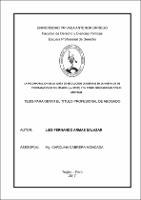| dc.contributor.advisor | Cabrera Moncada Carolina | |
| dc.contributor.author | Armas Salazar, Luis Fernando | |
| dc.creator | Armas Salazar, Luis Fernando | |
| dc.date.accessioned | 2017-03-07T16:40:22Z | |
| dc.date.available | 2017-03-07T16:40:22Z | |
| dc.date.issued | 2017 | |
| dc.identifier | T_DERE_320 | |
| dc.identifier.uri | https://hdl.handle.net/20.500.12759/2407 | |
| dc.description.abstract | El presente trabajo tiene como finalidad contribuir con el Sistema de administración
de Justicia peruano, en virtud de la reciente incorporación de los Dispute Boards
(DB) o también llamado Junta de Resolución de Disputas (JRD), en la Nueva Ley
de Contrataciones del Estado, Ley N°30225 y su respectivo reglamento (Decreto
Supremo 350-2015-EF).
La JRD constituye un nuevo mecanismo de resolución de Conflictos que se
desenvuelve en el ámbito de la construcción y que será nuestro objeto de estudio
a fin de dilucidar de qué manera se complementa con el Arbitraje; para lo cual
hemos destinado cuatro capítulos.
El Primer capítulo está enfocado en conceptualizar el problema en el marco de la
realidad jurídica y su identificación dentro de la realidad problemática. El Segundo
capítulo comprende el Marco Teórico del presente trabajo, abordado en seis títulos.
El Título I denominado: Mecanismos Alternativos de Resolución de Conflictos,
establece la facultad que tiene las partes de sustraerse a la jurisdicción ordinaria
para resolver sus disputas en el ámbito privado, desarrollando brevemente las
figuras de Conciliación, Mediación y más profundamente el Arbitraje; El Título II
desarrolla la figura de la JRD, estableciendo sus antecedentes, definiciones, ámbito
de aplicación, características, naturaleza jurídica, las modalidades en que éstas se
presentan, entre otros; El Título III abarca lo referente al tratamiento jurídico
Internacional aplicado a la JRD, mientras que el Título IV, el tratamiento jurídico
Peruano. Finalmente, El Título V recoge el debate referente a la competencia o
complementariedad entre la JRD y el Arbitraje, defendiendo la posición de la
‘complementariedad’ de ambos mecanismos, en virtud a la característica pre
arbitral de la JRD y su contribución conjunta en favor del perfeccionamiento de un
sistema de administración de justicia más moderno y eficiente.
El tercer capítulo presenta el sistema metodológico empleado para realizar el
trabajo, mientras que el cuarto y último está divido en cuatro Sub Capítulos en
donde se consignan todo lo referente a los Efectos, resultados, y conclusiones de
la presente investigación. | es_PE |
| dc.description.abstract | This work was made to contribute with the Peruvian Justice Administration System,
due to the recent incorporation of dispute boards (DB) in the new Employment Law
of the Estate, Law N° 30225 and it's respective regulations (Supreme Decree 3502015-EF).
DB are a new mechanism of conflict resolution in the construction field
and it will be our study subject to elucidate in what ways it complements with
arbitration, which is developed in four chapters. The first chapter is focused to
conceptualize the problem in the jury reality regards and its consequent
identification. The second chapter comprises the theoretical framework addressed
in four titles. Title 1 called alternative mechanisms of conflict resolution, establishes
the ability of the parts to withdraw to ordinal jurisdiction to solve their disputes in the
private field, briefly developing the figures of conciliation, mediation and arbitration;
title 2 develops the figure of DB, establishing its precedents, definitions, field of
action, characteristics, legal nature, the methods represented on it amongst others;
title 3 covers the international legal treatment applied to DB; while title 4 includes
the Peruvian legal treatment; finally title 5 develops the debate regarding the
relationship between DB, and arbitration, highlighting the complementarity between
these mechanisms due to the pre-arbitral traits of DB and its contribution to the
perfectioning of a Justice Administration System more modern and efficient. The 3rd
chapter presents the methodological approach used to perform the work. The 4th
and last chapter is divided into 4 subchapters: effects, results, and conclusions. | en_US |
| dc.description.uri | Tesis | |
| dc.format | application/pdf | es_PE |
| dc.language.iso | spa | es_PE |
| dc.publisher | Universidad Privada Antenor Orrego | es_PE |
| dc.relation.ispartofseries | T_DERE_320 | |
| dc.rights | info:eu-repo/semantics/openAccess | es_PE |
| dc.source | Universidad Privada Antenor Orrego | es_PE |
| dc.source | Repositorio institucional - UPAO | es_PE |
| dc.subject | Resolucion de Disputas | es_PE |
| dc.subject | Contrataciones del Estado | es_PE |
| dc.title | La incorporación de la junta de resolución de disputas en la nueva ley de contrataciones del estado (ley 30225) y su complementariedad con el arbitraje | es_PE |
| dc.type | info:eu-repo/semantics/bachelorThesis | es_PE |
| thesis.degree.level | Titulo Profesional | es_PE |
| thesis.degree.grantor | Universidad Privada Antenor Orrego. Facultad de Derecho y Ciencias Políticas | es_PE |
| thesis.degree.name | Abogado | es_PE |
| thesis.degree.discipline | Derecho | es_PE |

